Report reveals growth for MEWP rental market
15 July 2022
MEWP rental markets continued to recover strongly after the pandemic, despite clouds on the horizon. How are outlooks affected by uncertainty around geo-political upheavals and increasing input costs, driven by rising inflation and the war in Ukraine?
Matt Brereton, IPAF Communications Manager, summarises the 2022 report compiled exclusively for the International Powered Access Federation (IPAF) by Ducker.
 The report examines the European, US, Chinese and Middle Eastern MEWP rental markets. (Photo: IPAF)
The report examines the European, US, Chinese and Middle Eastern MEWP rental markets. (Photo: IPAF)
Most markets in Europe, the US and the Middle East continued to recover strongly, though a resurgence of Covid-19 and accompanying lockdowns and restrictions in some parts of China did hamper the recovery there, as well as causing knock-on effects in the supply of Chinese-manufactured MEWPs that were increasingly sought-after during 2021, owing to supply-chain issues affecting many western manufacturers.
The Global Powered Access Rental Market Report 2022 indicates that after a relatively cautious start to the year in which many countries under study were still dealing with second and third waves of the Covid-19 virus, most companies in the countries under study sought to increase rental fleet size and utilisation rates during 2021; post-pandemic recovery was fairly even worldwide and maintained a steady rate.
Companies returned to planned investment strategies and in fact supply struggled to keep up with demand in terms of new machines, especially specialist and all-electric MEWPs, owing mainly to the “whiplash” effect of the pandemic recovery on inputs including fuel prices, energy costs and raw materials, leading to increased lead times on new machines and an increasing reliance on older or second-hand machines to maintain fleets in line with demand.
This effect can be seen to have continued in the first half of 2022, driven by rising global energy costs, soaring inflation in most developed economies and exacerbated by the knock-on effects of Russia’s invasion of neighbouring Ukraine at the end of February 2022.
European MEWP rental market
Overall, the report indicates that the European MEWP rental market partially recovered from the pandemic in 2021, and overall showed revenue growth of 7% across 2021.
However, the market was only recovered quite slowly in the first half of the year in most countries under study, as lockdowns and public health measures were eased at different rates in different parts of Europe.
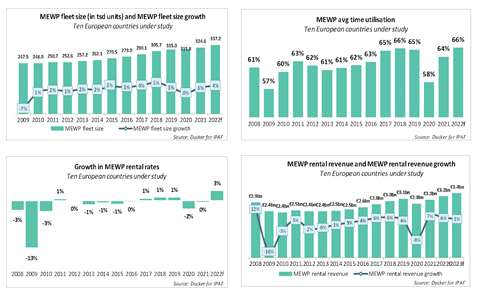 The report revealed steady growth for the European market. (Graph: Ducker)
The report revealed steady growth for the European market. (Graph: Ducker)
In 2021, Europe’s rental market reached €3 billion total revenue, to almost regain pre-pandemic levels of activity owing to recovering demand in both construction and non-construction sectors.
The European fleet stood at approximately 325,000 units at the end of 2021.
Utilisation rate went up by 6 percentage points, driven by the post-pandemic recovery and ongoing OEM MEWP shortages and supply issues.
Countries such as the UK (11% revenue growth), Italy (12%) and France (13%) that were hit hardest in Europe during 2020 demonstrated the fastest rates of recovery.
Elsewhere in Europe the recovery was more modest, inversely proportionate to the severity at which markets were affected in the first peaks of the pandemic: Spain and Sweden saw revenue growth in 2021 of 5%; Germany and Norway 3%; Denmark, Finland and the Netherlands all saw growth of just 2%.
By contrast the US market rebounded to grow by 15%, though this reflects both the significant hit the market took in 2021 and the fiscal recovery package unveiled by incoming US President Joe Biden.
Levels of investment grew tenfold, as rental companies resumed capital expenditure, looking for new MEWP suppliers with more agreeable lead times and in some cases receiving orders that were placed on hold or delayed during 2020.
Market outlooks for 2022 remained positive, but ongoing logistics and supply-chain problems caused by the pandemic, as well as the impact of war in the Ukraine on global markets and rising inflation, make forecasting increasingly difficult.
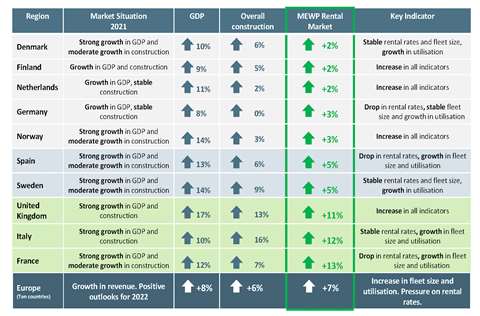 France saw the strongest revenue growth of all European countries included in the report. (Table: Ducker)
France saw the strongest revenue growth of all European countries included in the report. (Table: Ducker)
On the back of the strongest revenue growth of the European countries under study, France also recovered its position as having Europe’s largest total MEWP fleet.
Germany had crept ahead of France and the UK in terms of overall fleet size at the end of 2020, but a strong year saw France increase total fleet size to more than 62,000 at the end of 2021, compared with just over 60,000 units in Germany’s fleet and 58,000 in the total UK fleet.
Germany maintained the highest average revenue per MEWP unit among European countries under study, at just over €12,200 per MEWP. The Netherlands (€9,622 per unit), Italy (€9,436), and the UK (€9,109) were second, third and fourth, with France fifth on €8,890. Finland had the lowest at just €6,344 per unit.
Overall, European fleet mix remained stable through 2021 and is not forecast to change significantly in coming years, with scissors the dominant machine type in European fleets at just under half of total MEWP fleet share (49%), followed by booms at 38%, vehicle-mounted machines on 7% and around 6% of other machine types.
In terms of power sources, the transition to greener MEWPs including electric and hybrid machines continues strongly in all European countries under study, albeit slightly hampered by issue in terms of availability of new machines. Electric scissors are dominant in all countries, particularly the Netherlands, Nordic countries and Germany.
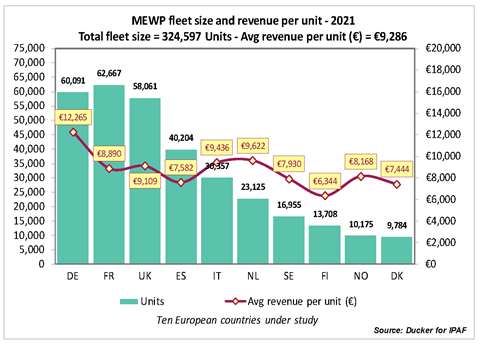 The French market increased its total fleet size to more than 62,000 at the end of 2021. (Graph: Ducker)
The French market increased its total fleet size to more than 62,000 at the end of 2021. (Graph: Ducker)
The transition towards electric scissors continues in the rest of Europe, but there remains significant use of diesel scissors for outdoor applications in most countries.
This transition is progressing at different speeds depending on the country and local demand for rough-terrain units, and machines over 20m heights in particular, as well as the availability of reliable charging infrastructure and the typical end-use sectors in each market. Most European rental companies expect to complete their transition to a “green” fleet in the next five to 10 years.
How did the US MEWP rental market perform?
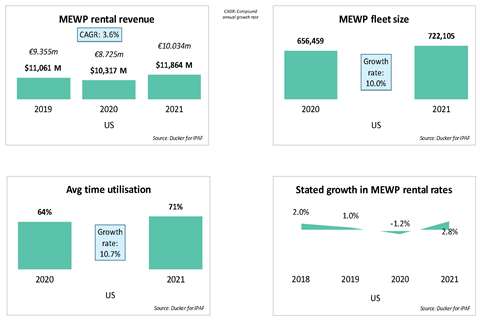 The US market was hit by disruptions to its supply chain. (Graph: Ducker)
The US market was hit by disruptions to its supply chain. (Graph: Ducker)
In the US, MEWP rental revenue increased by 15% across 2021 to surpass pre-pandemic levels, owing to rapid reopening of non-construction business and pent-up demand from construction projects paused during 2020.
With President Joe Biden being inaugurated in early 2021, the vaccine roll-out and post-pandemic recovery stimulus were instrumental in rebuilding confidence and rebounding activity in the US.
As well as revenue growth (driven in part by increased rental rates, driven up by demand for MEWPs), MEWP fleet size in the US grew by 10% in 2021, as rental companies resumed their pre-pandemic investment strategies and attempted to prevent utilisation rates from increasing too much.
Overall US fleet growth was hampered slightly by supply chain disruptions, as in other western markets, though the US as a whole was able to increase fleet size growth by more than 60,000 units, to stand at 722,105 by the end of 2021.
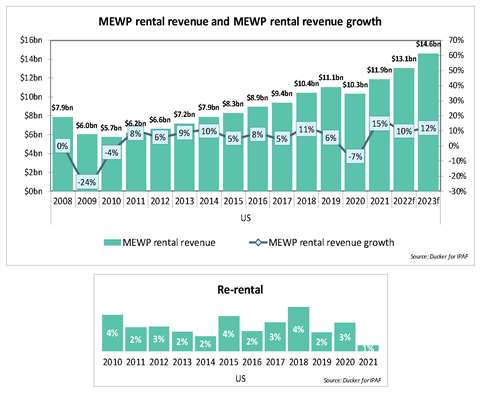 MEWP rental revenue increased by 15% across 2021. (Graph: Ducker)
MEWP rental revenue increased by 15% across 2021. (Graph: Ducker)
This growth is forecast to continue in 2022 but may be inhibited by inflationary pressures on the economy, as well as trade issues, including a prohibitive tariff ruling on Chinese MEWP imports announced in late 2021.
As was the case in European markets, overall fleet mix in the US remained stable across 2021, though scissor lifts have a slightly higher share of the overall fleet at 58% than in Europe (49%).
Also as in Europe, typical power source types continued progressing towards hybrid or all-electric machines during the year, albeit at a slower pace than in most European markets.
In the US, electric booms are not as much in demand, not only because of their limited autonomy and charging infrastructure deficiencies, but also because of climatic constraints that prevent the use of electric equipment outdoors during both the colder winter and humid summer months in many parts of the US.
Growth for Chinese access equipment rental market
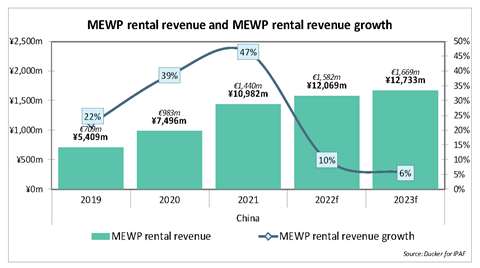 According to the report, Chinese MEWP rental market growth remained strong in 2021. (Graph: Ducker)
According to the report, Chinese MEWP rental market growth remained strong in 2021. (Graph: Ducker)
As in 2021, the 2022 report also contains a special market focus on China and on the Middle East Gulf Co-operation Council (GCC) countries of Saudi Arabia, UAE and Qatar.
The China report paints a picture of a MEWP rental market still growing at unprecedented speeds in 2020 and 2021, despite the peaks of the pandemic – Chinese MEWP rental market growth remained strong (47%) in 2021, driven mainly by fleet expansion.
However, uncertainty around continued outbreaks in key cities in China severely limited market optimism, giving rise to only moderate growth outlooks for 2022-23, with forecast annual revenue growth of 10% in 2022, and 6% in 2023.
It remains to be seen whether China’s turbo-charged MEWP rental market can confound subdued expectations, or if global economic headwinds, rising input costs, geo-political instability and trade friction can place a significant brake on what has been a runaway success across the past five years or so.
In terms of total fleet size, this continued expanding at a remarkable rate in China: The estimated total MEWP rental fleet expanded rapidly in 2021, reaching almost 330,000 units in total. Total fleet size is forecast to stand around 435,000 to 440,000 at the end of 2022.
After years of rapid growth, major Chinese rental company investment is expected to stabilise gradually. More moderate – but still double-digit – fleet growth is expected from 2023 onwards. Will the Chinese rental fleet one day exceed that of the US at some point in the next five years? At this sustained rate of growth, it is impossible to rule out.
Scissors account for the majority share in China’s rental fleets, at around 73% as of the end of 2021. Overall utilisation rate remained stable at 72% in 2021, having decreased slightly in 2020, while rental rates continued to fall, albeit at a slower pace than they fell across 2020.
Has demand for access fleets returned in the Middle East?
The picture was largely positive once again in the Middle East, with the recovery largely tracking the higher end of the European or the US market.
On average across the three countries under study revenue grew by 13%, compared with 13% for France, 15% for the US and 7%, the European average.
This recovery came largely as a result of improved average utilisation and rental rates, driven by the resumption of paused construction projects and new sources of revenue in facilities management.
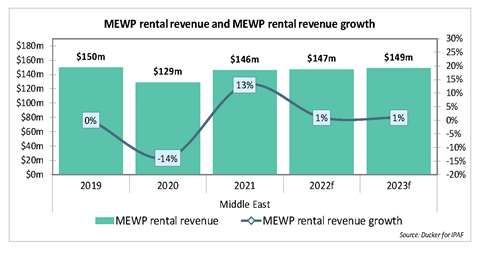 MEWP rental revenue hit $146 million in the Middle East. (Graphs: Ducker)
MEWP rental revenue hit $146 million in the Middle East. (Graphs: Ducker)
Total MEWP rental revenue recovered from the lows of the pandemic in all three countries under study, with combined annual revenue reaching $146 million, driven by ongoing infrastructure investment in the region and business generated by the Dubai Expo trade fair in the fourth quarter of the year.
In 2022, revenue is expected to grow at varying speeds depending on the country: Qatar is experiencing rapid growth as the market expands; with less dynamic growth in Saudi Arabia and the UAE.
In 2021, the total fleet size in the three Middle East countries under study grew by around 2%, owing to rental companies increasing their fleets to pre-pandemic levels to keep pace with the recovering demand.
For 2022, respondents expect to continue buying machines, increasingly turning to Chinese MEWP manufacturers who, in the current climate of supply-chain disruption, are more able to guarantee shipments than western OEMs.
Fleet mix was fairly stable, with a slight increase in the share of vertical or spider-type lifts; boom-type machines are predominant in Middle Eastern fleets, at just under half of the total rental fleet.
While diesel-powered booms still represent the bulk of the MEWP fleet in all three countries under study, the share of electric-powered equipment is expected to grow (especially in the UAE, less so in Saudi Arabia) as end-use pivots towards more facilities management and there is an increased focus on workplace safety and occupational health, which is seeing scaffolding phased out in favour of electric scissor lifts on internal maintenance and fit-out projects.
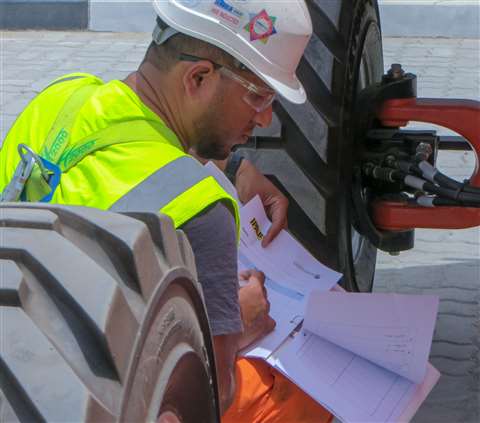 The fleet size in the Middle Eastern countries included in the report increased by 2% (PHOTO: Ducker)
The fleet size in the Middle Eastern countries included in the report increased by 2% (PHOTO: Ducker)
In summary, fleet sizes and rental revenue are increasing in all markets under study, investment confidence has returned, the pivot towards electric and hybrid-powered machines continues apace and even well-documented supply chain issues cannot dampen optimistic outlooks for the next few years.
While there are undoubtedly clouds of uncertainty on the horizon the outlook remains bright for the powered access rental industry in most development markets for the foreseeable future.
For detailed analysis of European, US, Chinese and Middle Eastern markets, the 2022 IPAF Global Powered Access Rental Market report is available now.
IPAF members can apply for a free copy of the relevant market report now by filling in a form at www.ipaf.org/reports; the report is also available for non-members to purchase.
STAY CONNECTED



Receive the information you need when you need it through our world-leading magazines, newsletters and daily briefings.
CONNECT WITH THE TEAM














